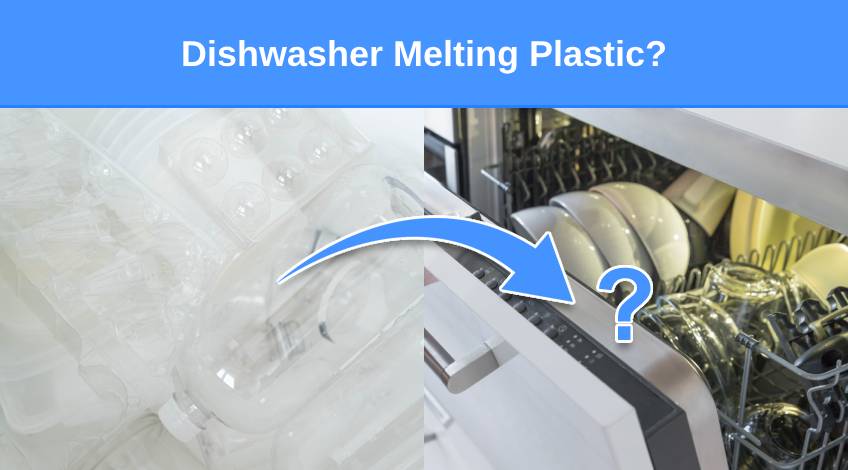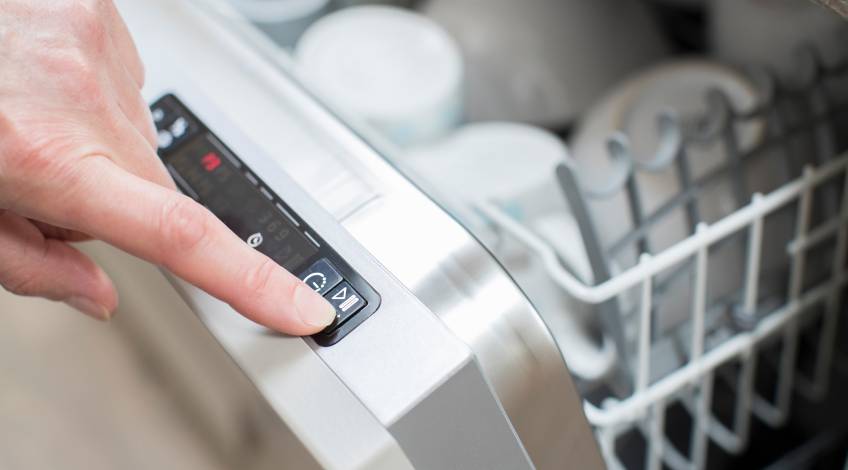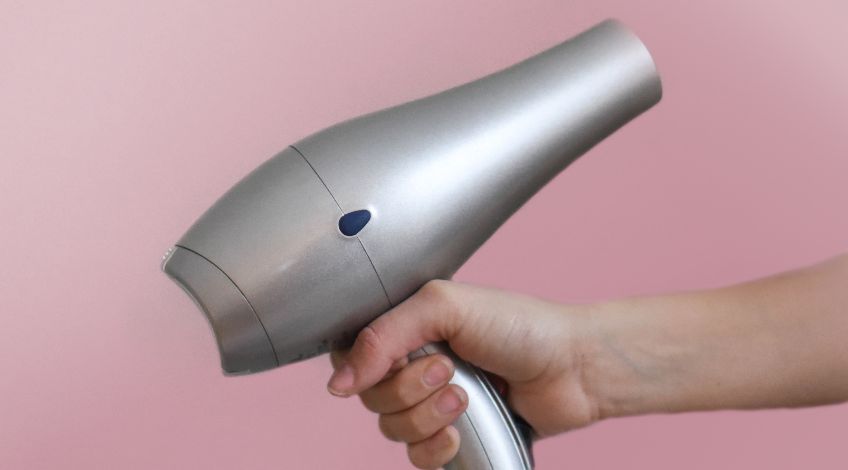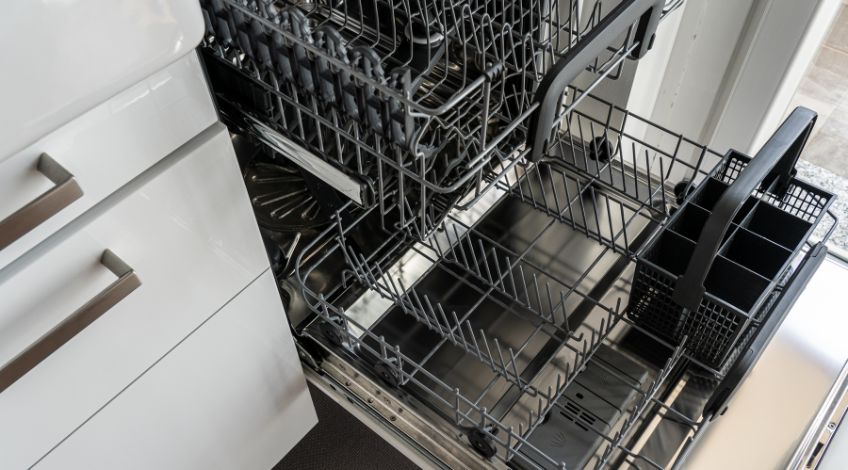
Dishwasher Melting Plastic? Here’s why & what to do
If you have just discovered that your dishwasher is melting plastic items it can be pretty worrying. But it’s not really that uncommon of an occurrence.
The problem is the combination of water, heat and the fast cleaning process created in a dishwasher can often lead to plastic items melting.
Although this problem is quite serious, there’s no need to panic, because in this article we look into the problem of melting plastic in the dishwasher and offer several ways to solve this annoying and worrying problem.
Why Is The Dishwasher Melting Plastic?
There can be a number of reasons why the dishwasher is melting plastic, which include;
| Possible Cause | Solution |
|---|---|
| Plastic items placed too close to the element | Ensure plastic items are placed as far away from the heating element as possible |
| Placing non dishwasher safe items in the dishwasher | Always ensure all plastic items are dishwasher safe |
| Stacking The Racks Incorrectly | Consult the user manual for safe loading instructions |
| Exposing plastics to high drying temperatures | Remove plastic items before the drying cycle commences |
| Placing damaged plastic items in the dishwasher | Always inspect plastic items for cracks etc |
| Selecting an incorrect setting | Always select a low heat cycle when washing plastics |
| Placing plastics too low (close to the element) | Adjust the racks accordingly |
| Defective heating element | Inspect and replace the heating element if necessary |
Placing Plastic Items Close To The Heating Element
This is the most common reason for plastic items melting in the dishwasher. Placing plastic containers, bowls or utensils too close to the heating element can cause them to melt during a wash cycle.
This can lead to bits of melted plastic sticking to the heating element and other surfaces in the appliance.
The heating element is typically located at the bottom of the appliance. This means the safest place for plastic items is on the upper rack which is further away from the area where heat is produced.
Placing Non Dishwasher Safe Plastics In The Dishwasher

This is another common reason for melted plastic in the dishwasher. You should only ever place heat resistant or dishwasher safe plastic items in the dishwasher.
The intense heat produced during a wash cycle is more than enough to melt non dishwasher safe plastics.
You should always look for the dishwasher safe logo which is a square with some plates or a glass inside it. The symbol will also feature some water drops or diagonal lines.
This symbol signifies that the item is strong enough to withstand the high heat produced by the dishwasher without melting or releasing harmful chemicals.
If the plastic items in question do not display the dishwasher safe symbol, they could melt, warp or release toxic chemicals.
Loading The Dishwasher Incorrectly

If a plastic item falls onto or close to the heating element in your dishwasher, it could melt and get stuck to the heating element or other parts of the appliance. This is most likely if the plastic items are not secured properly in the dishwasher.
You should consult your user manual for the best way to stack any plastic items in your dishwasher. In the absence of a user manual, you should never place any plastic items close to the heating element.
Plus all plastic items should be placed in such a way as to not touch any surfaces of the dishwasher that might become hot during the cycle.
Exposing The Plastics To Excessive Heat When Drying
The drying cycle on a dishwasher can produce high temperatures. These high temperatures and the closeness of the plastic to the heating element can cause them to melt.
Always ensure that plastics are placed as far away from the heating element as possible.
Another good tip is to remove plastic items before the drying sequence commences if possible. As soon as the wash cycle has completed, either cancel the cycle or just open the door and remove the plastic items and allow them to air dry.
Placing Damaged Or Worn Plastics In The Dishwasher
Plastic items that are cracked, scratched or worn, even dishwasher safe plastics, are more likely to melt if exposed to the intense heat present during a dishwasher’s cycle.
Any break in the surface finish of the plastic allows the heat to penetrate which could cause the item to melt. You should inspect all plastic items even if they are dishwasher safe and avoid placing any damaged or scratched items in the appliance.
Choosing An Incorrect Setting

Many dishwashers have a cycle specifically for washing plastic items which are designed to prevent plastics and other sensitive items from becoming damaged.
These cycles typically use cooler water and reduced drying times to protect delicate items. Selecting this cycle when washing plastics will reduce the chances of the items melting or warping.
Not Using The Adjustable Rack Option
If your appliance has an adjustable upper rack, you can lower it to allow extra space between the plastic items and the heating element.
Increasing the distance between the high heat produced by the heating element and the plastic items will reduce the chances of warping or melting.
Defective Heating Element
In some cases, the heating element can be defective which can lead to it producing too much heat. This will increase the chances of plastic items melting or becoming warped.
If you suspect the heating element on your dishwasher is defective, we recommend contacting a technician.
How To Remove Melted Plastic From A Dishwasher

If you have been unfortunate enough to get plastic melted onto the element of your dishwasher it can seem like such a disaster. Every time the element heats up it will fill the kitchen with the smell of burning plastic.
Those burning plastic fumes can be toxic which is why you need to do something as soon as possible. But don’t panic because below we have the easiest way to remove melted plastic from the dishwasher.
You Will Need:
- A Hairdryer
- A Wooden Skewer (or wooden toothpick)
- Damp Cloth
- Metal Tongs
All You Need To Do Is:
- Turn Off The Dishwasher
In the interest of safety, you should disconnect the power supply. - Open As Many Windows As Possible
The smell of burning plastic doesn’t only smell bad, it can be toxic. So you need to open as many windows as you can to remove that burnt plastic smell. - Remove As Much Plastic As You Can
Using a pair of metal tongs, remove as much of the melted plastic as you can. - Heat The Stuck On Melted Plastic
Using the hairdryer, heat the plastic for around 60 seconds. - Remove All Of The Stuck On Plastic
Using the wooden skewer (or toothpick) scrape all of the melted plastic from the element. This might take some time and be sure to remove all of the small pieces that fall to the bottom of the appliance. - Wipe The Element
Using a damp cloth, wipe the element to ensure all plastic bits have been removed. - Run A Quick Cycle
Once all of the plastic has been removed, run a quick cycle that includes the heated dry function to remove any lingering pieces of plastic that you might have missed.
Ways To Prevent Plastic From Melting In The Dishwasher

There are several ways you can prevent plastic from melting in the dishwasher which include;
- Check That All Plastic Items Carry The Dishwasher Safe Symbol
- Place Plastic Items Securely On The Racks
- Always Place Plastic Items As Far Away From The Heating Element As Possible
- Avoid Placing Any Damaged Plastic Items In The Dishwasher
- Select A Cooler Wash Cycle When Washing Plastic Items
- Remove Plastic Items Before Drying Cycle Starts
- Keep To A Regular Cleaning Schedule With Your Dishwasher
SEE ALSO: Dishwasher Smells Like Burning? (here’s why & what to do)
Frequently Asked Questions
The main reason why plastic melts in the dishwasher is if it isn’t dishwasher safe plastic. Other reasons include, cracked or damaged plastic items are more susceptible to heat damage and placing plastic items too close to the heating element can also cause them to melt.
The most effective way to remove melted plastic from the heating element is to heat the plastic using a hairdryer (it takes around 60 seconds) then remove the plastic using a wooden skewer (or toothpick).
The fumes created from melted plastic can be toxic which is why we recommend opening as many windows as possible if you smell burning plastic.
Also, follow us on Pinterest ...



